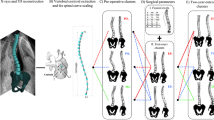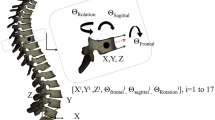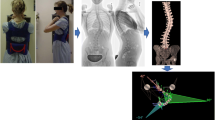Abstract
Purpose
Surgical instrumentation for adolescent idiopathic scoliosis (AIS) is a complex procedure where selection of the appropriate curve segment to fuse, i.e., fusion region, is a challenging decision in scoliosis surgery. Currently, the Lenke classification model is used for fusion region evaluation and surgical planning. Retrospective evaluation of Lenke classification and fusion region results was performed.
Methods
Using a database of 1,776 surgically treated AIS cases, we investigated a topologically ordered self organizing Kohonen network, trained using Cobb angle measurements, to determine the relationship between the Lenke class and the fusion region selection. Specifically, the purpose was twofold (1) produce two spatially matched maps, one of Lenke classes and the other of fusion regions, and (2) associate these two maps to determine where the Lenke classes correlate with the fused spine regions.
Results
Topologically ordered maps obtained using a multi-center database of surgically treated AIS cases, show that the recommended fusion region agrees with the Lenke class except near boundaries between Lenke map classes. Overall agreement was 88%.
Conclusion
The Lenke classification and fusion region agree in the majority of adolescent idiopathic scoliosis when reviewed retrospectively. The results indicate the need for spinal fixation instrumentation variation associated with the Lenke classification.
Similar content being viewed by others
References
Aubin CE, Labelle H, Ciolofan OC (2007) Variability of spinal instrumentation configurations in adolescent idiopathic scoliosis. Eur Spine J 16(1): 57–64
Carman DL, Browne RH, Birch JG (1990) Measurement of scoliosis and kyphosis radiographs: intraobserver and interobserver variation. J Bone Joint Surg Am 72: 328–333
Cil A, Pekmezci M, Yazici M (2005) The validity of lenke criteria for defining structural proximal thoracic curves in patients with adolescent idiopathic scoliosis. Spine 30: 2550–2555
Duda RO, Hart PE (1973) Pattern Classification and Scene Analysis. Wiley, New York
Duong L, Cheriet F, Labelle H (2006) Three-dimensional classification of spinal deformities using fuzzy clustering. Spine 31(8): 923–930
Kohonen T (1995) Self-organizing maps. Springer, Berlin
LeBail E, Mitiche A (1989) Quantification vectorielle d’images par le rèseau neuronal de kohonen. Traitement du Signal 6(6): 529–539
Lenke L (2007) The lenke classification system of operative adolescent idiopathic scoliosis. Neurosurg Clin N Am 18(2): 199–206
Lenke LG, Betz RR, Bridwell KH, Clements DH, Harms J, Lowe TG, Shufflebarger HL (1998) Intraobserver and interobserver reliability of the classification of thoracic adolescent idiopathic scoliosis. J Bone Joint Surg Am 80: 1097–1106
Lenke LG, Betz RR, Harms J, Bridwell KH, Clements DH, Lowe TG, Blanke K (2001) Adolescent idiopathic scoliosis: a new classification to determine extent of spinal arthrodesis. J Bone Joint Surg Am 83: 1169–1181
Lenke LG, Betz RR, Clements D, Merola A, Haher T, Lowe T, Newton P, Bridwell KH, Blanke K (2002) Curve prevalence of a new classification of operative adolescent idiopathic scoliosis. Spine 27(6): 604–611
Lippman R (1987) An introduction to computing with neural networks. IEEE ASSP Mag 3: 4–22
Loder RT, Urquhart A, Sten H (1995) Variability in cobb angle measurements in children with congenital scoliosis. J Bone Joint Surg Am 77: 768–770
Lowe TG, Alongi PR, Smith DAB (2003) Anterior single rod instrumentation for thoracolumbar adolescent idiopathic scoliosis with and without the use of structural interbody support. Spine 28: 208–216
Lowe TG, Alongi PR, Smith DAB (2003) Anterior single rod instrumentation for thoracolumbar adolescent idiopathic scoliosis with and without the use of structural interbody support. Spine 28: 2232–2241
Mezghani N, Chav R, Humbert L, Parent S, Skalli W, de Guise JA (2008) A computer-based classifier of three dimensional spinal scoliosis severity. Int J Comput Assist Radiol Surg 3(1–2): 55–60
Mezghani N, Cheriet M, Mitiche A (2003) Combination of pruned kohonen maps for on-line Arabic characters recognition. In: Seventh international conference on document analysis and recognition, vol 2, Edinburgh. pp 900–905
Mitiche A, Aggarwal JK (1996) Pattern category assignement by neural networks and the nearest neighbors rule. Int J Pattern Recog Artif Intell 10: 393–408
Oja M, Kaski S, Kohonen T (2003) Bibliography of self-organizing map SOM papers: 1998–2001 addendum. Neural Comput Surv 3: 1–156
Phan P, Labelle H, Ouellet J, Mezghani N, de Guise JA (2011) The use of a decision tree based on the literature can efficiently output the levels of fusion alternatives in the surgical treatment of ais. In: Canadian spine society annual meeting
Ritter H, Schulten K (1988) Kohonen’s self-organizing maps: exploring their computational capabilities. In: IEEE international joint conference on neural networks, pp 109–116, San Diego
Robitaille M, Aubin CE, Labelle H (2007) Intra and interobserver variability of preoperative planning for surgical instrumentation in adolescent idiopathic scoliosis. Eur Spine J 16(10): 1604–1614
Sabourin M, Mitiche A (1993) Modeling and classification of shape using a Kohonen associative memory with selective multiresolution. Neural Netw 6(2): 275–283
Stokes IA, Sangole AP, Aubin CE (2009) Classification of scoliosis deformity three-dimensional spinal shape by cluster analysis. Spine 34(6): 584–590
Su M, Chang H, Chou C (2002) A novel measure for quantifying the topology preservation of self-organizing feature maps. Neural Process Lett 15: 137–145
Tso B, Mather PM (2009) Classification methods for remotely sensed data. 2nd edn. CRC Press, New York
Uriarte E, Martín F (2005) Topology preservation in som. Int J Appl Math Comput Sci 1: 19–22
Author information
Authors and Affiliations
Corresponding author
Rights and permissions
About this article
Cite this article
Mezghani, N., Phan, P., Mitiche, A. et al. A Kohonen neural network description of scoliosis fused regions and their corresponding Lenke classification. Int J CARS 7, 257–264 (2012). https://doi.org/10.1007/s11548-011-0667-0
Received:
Accepted:
Published:
Issue Date:
DOI: https://doi.org/10.1007/s11548-011-0667-0




